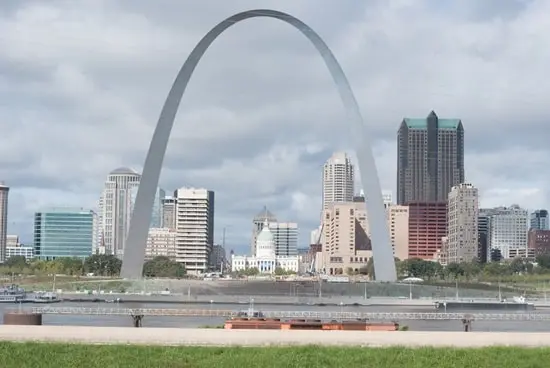St. Louis, a metropolis steeped in cultural richness, beckons visitors year-round with its diverse attractions and verdant landscapes. The city’s charm, enhanced by its affordable living costs, had once sparked a significant population influx.
Many found themselves captivated by the unique mix of urban sophistication and small-town charm. However, recent years have cast a shadow over this once-gleaming reputation.
A disconcerting WalletHub study has positioned St. Louis at the nadir of safety rankings among U.S. cities. This condition was attributed to poor home and community systems, increased natural disaster risk, and no financial security.
However, amidst these challenges, a glimmer of hope emerges—innovative technology. St. Louis can leverage cutting-edge solutions to become a smart city, enhancing safety and potentially reversing the population decline.
The Specter of Rising Crime
In a disturbing turn of events, St. Louis found itself ranked seventh on the global list of dangerous cities in 2022, according to Statista. Moreover, according to 5 On Your Side, by August of the same year, the city had witnessed over 25 homicides.
The River Front Times has highlighted a stark reality: Black Missourians face unparalleled safety risks in St. Louis compared to other U.S. locations. This disparity has deep roots in the city’s tumultuous history of racial unrest, which reached its zenith in the 1990s.
The powder keg of tension was ignited by glaring income disparities and a dearth of employment opportunities. Today, neighborhoods like Gravois Park, the Central West End, and Dutchtown are stark reminders of this ongoing struggle.
Crime Prevention with a Data-Driven Approach
St. Louis’s high crime rates, particularly violent crime, necessitate a shift towards data-driven policing strategies. Advanced analytics of crime data can identify spatiotemporal patterns and predict areas with a higher likelihood of criminal activity.
This allows for a more proactive deployment of police resources, potentially deterring crime before it happens.
Sensor networks like ShotSpotter technology can be crucial in real-time crime response. According to NewsNation, this technology can detect real-time gunshots due to its advanced acoustic surveillance system. It is currently being used in over 140 US states.
It utilizes 20-25 sensors per square mile, mounted on buildings or poles, sensitive to impulsive sounds like gunfire. These sensors rapidly transmit data to law enforcement. This enables police dispatch within 60 seconds of a gunshot.
Furthermore, empowering residents with mobile apps for reporting suspicious activity and facilitating communication with neighbors can foster a more vigilant community. Imagine a network of residents acting as additional eyes and ears for law enforcement, creating a denser safety net.
Increasing Number of Road Accidents
St. Louis’s thoroughfares present a formidable challenge to even the most seasoned motorists. In 2022, the city bore witness to a staggering 7,500 pedestrian fatalities in road incidents.
According to Fox 2 Now, a fatal hit-and-run incident in May 2024 resulted in a woman’s death. She was hit by a car while she was crossing a street on Page Avenue. While the woman died on the spot, the driver of the car fled.
These alarming facts are not merely numbers. They reflect the city’s unique position as a nexus for national cargo and freight transportation.
The streets of St. Louis are a veritable gauntlet of 18-wheeler trailers, trucks, and semi-trucks. These behemoths of the road pose an ever-present threat to smaller vehicles and pedestrians alike. When involved in an accident involving a truck, the damages are almost always fatal.
In such a gruesome catastrophe on the roads, the aftermath is often devastating. Victims may find themselves grappling with life-altering injuries and embroiled in complex legal battles. In such situations, the expertise of a St. Louis trucking accident lawyer becomes invaluable, guiding the injured through the labyrinthine legal process.
The intricacy of these cases is further compounded by the presence of multiple liable parties. As TorHoerman Law elucidates, plaintiffs often find themselves confronting the truck driver, the trucking company, and even the cargo-loading entity. This multifaceted approach to liability adds layers of complexity to an already overwhelming legal landscape.
Taming Traffic with Tech
St. Louis’s economic lifeblood, heavy freight traffic, poses a safety threat to pedestrians. Here’s how tech can help:
- Big Data Traffic Lights: Real-time data can optimize signal timings. This can go a long way in reducing congestion and creating predictable patterns for safer pedestrian crossings.
- Smarter Cars, Safer Streets: Encouraging vehicles with features like Automatic Emergency Braking (AEB) and Lane Departure Warning (LDW) can be a game changer. These systems can mitigate accidents caused by human error.
- Vehicle-to-Everything (V2X) Communication: Imagine an interconnected infrastructure where traffic lights and crosswalks communicate with vehicles. Moreover, they can also adjust timings based on traffic flow and pedestrian presence.
These solutions require collaboration, but the benefits are undeniable: a safer city, smoother traffic flow, and a thriving economy.
Nature’s Wrath
St. Louis finds itself precariously positioned at the confluence of nature’s forces. According to Forbes, Missouri has endured over 50 severe natural disasters in the past decade. These calamities have inflicted an annual average of $4.6 billion in damages.
The city’s geography, nestled between two major rivers and crisscrossed by tributaries, renders it particularly susceptible to flooding. Since 2008, St. Louis has grappled with six major inundations, transforming this natural phenomenon into a recurring nightmare for residents.
The city’s vulnerability extends beyond water-related calamities. St. Louis’s proximity to the New Madrid and Wabash Valley seismic zones places it squarely in earthquake-prone territory. This geological instability adds an extra element of uncertainty to the city’s volatile tryst with nature.
These natural calamities often transform city streets into treacherous obstacle courses. Even the most adept drivers find themselves challenged when navigating interstates like I-64 and I-44 during inclement weather.
A harrowing incident unfolded in February 2024 as a severe winter storm paralyzed the region. The Interstate-70 in Eastern Missouri succumbed to a two-hour shutdown, caused by a multi-vehicle pileup on snow-blanketed roads.
These events serve as sobering reminders of the real and present dangers posed by adverse weather conditions in St. Louis. Here, the residents must remain perpetually vigilant, aware that nature’s caprices can transform familiar roadways into perilous pockets at a moment’s notice.
Weathering the Storms
St. Louis’s vulnerability to floods and earthquakes necessitates tech-driven preparedness:
- Early Warning Systems: Advanced weather monitoring systems can provide real-time flood alerts, allowing residents to evacuate and protect property.
- Seismic Sensors: A network of sensors can detect earthquakes and trigger automated safety measures, mitigating damage.
- Resilient Infrastructure Development: Utilizing innovative materials and design principles can create infrastructure that withstands natural disasters better.
The Educational Dilemma
Once celebrated as “The Gateway to the West,” St. Louis faces a troubling exodus. The city’s population dwindled by 2.5% in 2023, partly due to its struggling education system.
The Missouri Independent reflects this dire situation in its report. According to it, St. Louis’s elementary and middle school students are caught in a learning pandemic. The city’s educational standards were ranked lowest nationwide.
This crisis spans both the public and private sectors. Middle-class families seeking better options increasingly turn to costly private schools. Yet, academic outcomes remain poor across all educational settings.
Krystal Barnett’s experience illustrates this dilemma. After transferring her fourth-grader from private to public school, she witnessed an alarming increase in her daughter’s aggressive behavior. There were complaints about her hitting students.
The Krystal scenario echoes the challenges many St. Louis parents face: balancing quality education against a flawed, expensive system.
The educational predicament in St. Louis threatens to perpetuate cycles of underachievement and inequality. Comprehensive educational reforms have now become increasingly urgent and vital for the city’s future prosperity.
Digital Upgrade for Education
St. Louis’s educational landscape stands at a critical juncture, poised for a technological revolution that could redefine learning outcomes. To catalyze this transformation, these advanced solutions can come in handy:
- Adaptive Learning Systems: Some AI-driven platforms can analyze student performance and dynamically adjust curriculum difficulty. This can optimize learning outcomes.
- Immersive Learning Environments: Integrating VR and AR technologies with haptic feedback devices can present a whole new world of learning. This can create interactive 3D simulations, enhancing understanding of complex concepts.
- Remote Education Infrastructure: High-bandwidth telepresence systems with 4K video conferencing and real-time translation capabilities can enable seamless cross-geographical interactions.
Systematic implementation of these technologies can provide equitable access to high-quality, personalized learning experiences.
FAQs
Q: What are the main safety concerns in St. Louis?
A: The main safety concerns in St. Louis include rising crime rates, particularly affecting the African American community. Increasing road accidents due to heavy freight traffic and natural disasters, such as floods and earthquakes, also threaten life. The city also faces educational challenges, contributing to population decline.
Q: What tech can help St. Louis prepare for natural disasters?
A: Advanced weather monitoring systems can provide real-time flood alerts. Seismic sensors can detect earthquakes and trigger automated safety measures. Additionally, using innovative materials can create infrastructure that better withstands natural disasters.
Q: What issues does St. Louis face in its education system?
A: St. Louis’s education system is ranked among the lowest nationwide. Both public and private schools struggle with poor academic outcomes. This has led to a learning crisis, causing middle-class families to seek alternatives and contributing to the city’s population decline.
St. Louis’s struggles aren’t unique, but they’ve hit hard. Families weighing their futures here face tough choices. Some stay, determined to be part of the solution; others leave, seeking safer pastures.
However, this adversity presents a unique opportunity. By embracing cutting-edge technology, the city can transform into a model smart city. From data-driven policing to weather prediction systems, these solutions have the potential to create a safer, more vibrant St. Louis.
This technological leap of faith can reverse the population decline and usher in a new era of prosperity for Gateway City.

Brandon is the cheif editor and writer at WorldUnfolds.com. With a passion for storytelling and a keen editorial eye, he crafts engaging content that captivates and enlightens readers worldwide.















